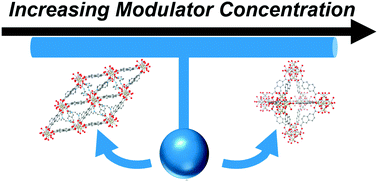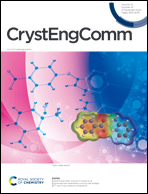Modulation of crystal growth and structure within cerium-based metal–organic frameworks†
Abstract
The intriguing catalytic properties of cerium-based materials have motivated the development of Ce-based metal–organic frameworks (MOFs). However, the controlled crystallization of Ce MOFs remains nascent due to complications with the high reduction potential of Ce4+ species. Modulators offer a route in other well-studied coordination networks to slow down crystallization processes to allow for corrective, uniform crystal growth. Herein, we report an investigation of modulator identity and concentration on the synthesis of a Ce-UiO-type MOF with 2,6-naphthalenedicarboxylic acid (NDC) as a linker. At low concentrations using both benzoic acid and trifluoroacetic acid, we observed a mononuclear Ce3+ MOF (NU-350) through single-crystal X-ray diffraction studies. Higher modulator concentrations yielded pure-phase Ce-UiO-NDC, with uniform particle sizes observed with utilizing benzoic acid as a modulator. Moreover, we demonstrated the transferability of this synthesis through the pure-phase synthesis of Ce-UiO-66 with benzoic acid as a modulator. High-resolution transmission electron microscopy showed a single crystalline domain within Ce-UiO-NDC.



 Please wait while we load your content...
Please wait while we load your content...